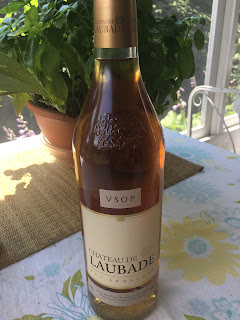The Package
There is a knock on the door and suddenly the bell rings loudly. There is another feverish knock. I open the door and the post man smiles and says, ‘Sign for this please’ and hands me an electronic pad to sign.
After business is taken care of, the post man smiles and suggests that I open the package-as is the case when packages that contain wine are delivered to me. Its sort of a ritual for the two of us.
He comes inside. I take out a paring knife to open the secured brown box, which is bound with brown, sticky tape. I open the box-there are no technical sheets or a handwritten notes-just four bottles of wine. The mailman, as part of the ritual, takes out bottle number one. It is a 2016 Sancerre named ‘Liberte’. I grab the second bottle, a 2016 Vermentino ‘Tuvaoes’from Sardegna. I’m beginning to think oysters…
The mailman lifts the third bottle out of the box-it’s a Rose-but, one I have read about and heard that it was the Rose everyone drinks in the Hamptons-Maison Belle Claire 2016 from Provence. I took out the final bottle, number four. It was red, from Tuscany and a 2014 Terigi Pugnitello-probably made with one of my favorite grapes-Sangiovese.
The opening of The Package was complete. Like normal, I assured the postman that I would leave a quarter of each bottle for him to sample. I would put the bottles in a canvas wine bag and leave it for him inside the garage door. We have been doing this exercise for many years-it’s educational for him, as I leave notes with each wine he samples.
This is our pet project.
The wine was delivered Saturday morning. By Sunday evening, I had the usual suspects over to share a meal and taste and comment on the wine. With four bottles and six people, the task should be flawless.
I am not one for matching food with wine, but, the Sancerre, Vermentino and Rose all call out for seafood: clams, oysters, scallops and shrimp.
For dinner, I made a seafood stew with saffron and the seafood I mentioned except oysters, which we ate on the half shell-definitely intended for the Vermentiono.
The wines which arrived were from Romano Brands, owned by a very innovative importer/distributor, Michael Romano, who I met nearly twenty years ago, as I began my wine journey. I do know, his Rose, Maison Belle Claire is a homage to his wife, whose name is Claire (the same as my mother).
Before reviewing the wines, I must admit that the four wines that were sent to me immediately made me realize that Michael Romano put a lot of thought into the contents of the package, a Sancerrre, a Vermentino, a Rose and a Tuscan red.
Our findings:
2016 Liberte Sancerre
This Sauvignon Blanc from the Loire Valley is magnificently crafted. The limestone delivers a creamy and rich white wine that epitomizes what acidity and smokiness can do when paired effectively together. Its an amazing bottle that retails for under $20. The wine has magical qualities that develop in the palate and grow in length as it seems to bubble an ambitious lemon-lime flavor in your mouth.
2016 Tuvaoes Vermentino di Sardegna by Cherchi. The origin of Vermentino in Sardegna is unclear. But in 1996, the first DOCG Vermentino was acknowledged. Since then, high quality Vermentiono’s have been making their way into the New World. With Tuvaoes at a little under $30 a bottle, you are reaching the islands ultimate product, a soft and fruity white wine that must be served very cold. The citrus notes scream for a little spice on the palate, if not, seafood. This bottle was extremely pleasing, seamless, bright, dry, crisp with truly balanced acidity. Personally, this was the best Vermentino I had sampled in my lifetime.
2016 Maison Belle Claire Rose. This mixture of Syrah, Grenache and Cinsault stole my heart. Its crisp acidity and light, dry citrus notes create a complex, dry Rose that is both rich and fresh on the palate. We first sampled Maison Belle Claire as an aperitif, then put it in its rotation after the Vermentino. The wine is stunning-it’s the talk of the Hamptons and the world beyond. At well under $20 a bottle, the Rose steal of the summer and beyond is here to stay. Its not a wine to cellar, but, one to drink immediately.
2014 Terigi Toscana Pugnitello. The Sangiovese grape is what Tuscany is known for. Think Chianti. Add a specific indigenous grape, Pugnitello to the blend and, in this case, you create a special red wine that is terroir specific. It’s a big wine meant to pair with beef, lamb and cured meats. The plump tannins cut the fat, while the acidity helps to balance this monster of a wine. The dark hue from the pugnitello grape adds distinction to this rich, bold wine. (under $25)
The tasting has ended and four, quarter bottles of wine are waiting for our mailman to retrieve.
I wonder what his thoughts will be???
To learn more about these wines and others, visit: www.romanobrands.com
Philip S. Kampe
Philip.kampe@thewinehub.com




































































